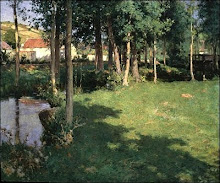The Austrians seem to have a thing for squares. Gustav Klimt used the square format almost exclusively, and the Czech/Austrian modernist architect Adolf Loos popularised the use of square windows in his facades.
These square paintings are by Carl Moll, another Austrian.
Moll successfully incorporated into his work Impressionist techniques of colour and brushwork, and the compositional daring of Modernism, while still preserving 19th century accuracy.
Despite its quality, Moll's work has been pushed to the side somewhat (I only discovered it fairly recently). A founding member of the Vienna Secession, he exhibited with Klimt, and was considered his equal. Both artists broke away from the Secession in 1905.
Perhaps the main reason for art history's side-lining of Moll was his enthusiasm for the Nazi Party. It was very disappointing to read about this in his biographical data. There were some Jewish connections in his family, and it's possible that he wanted to be seen as a Nazi supporter as a means of camouflaging himself and his family. Moll's attitudes were conflicted, he was on very cordial terms with his Jewish son-in-law Gustav Mahler, but like most Austrians of his time and class he was anti-semitic. The fact that he committed suicide as the Russians marched on Vienna in 1945, unfortunately suggests that he was loyal to the Third Reich to the bitter end.
.jpg)





.jpg)













+1900.bmp)